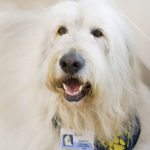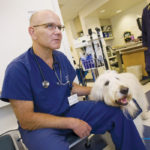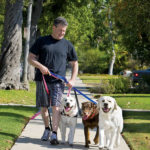Therapy Dogs and Healing
The small shapes lay motionless, each cocooned in a protective sheath of wires and tubing as a team of nurses ministered to their needs. On this day, the pediatric intensive care unit at UCLA Medical Center was filled to capacity. Above the low hum of voices and the occasional squeak of a rubber shoe on polished floors floated the hypnotizing bleeps of monitoring equipment. A blue fluorescent light washed over everything and seemed to magnify the smallest detail—a few drops of blood here, a splash of yellow fluid there, the pale skin of a seriously ill child farther on. Parents hovered in corners, not wanting to get in the way, but fearful to leave.
Into this sanctum stepped Laura Berton-Botfeld with her therapy dog—a 70-lb blond poodle named Apollo. The father of one of the patients spotted them and came quickly to her side. “Over here,” he said, tugging on her arm. Laura and Apollo moved to the bed of his 10-year-old daughter, whom we’ll call Sophia to protect her privacy. The delicate, wan figure under the sheets had bacterial meningitis—an inflammation of the brain that can be fatal. By the time Laura and Apollo arrived, the girl had been in a coma for seven days, and things were not looking good. Doctors had told the parents to prepare for the worst.
Sophia’s dad propped his daughter up with pillows. Her unseeing eyes were wide open, a beautiful blue, framed by lank blond hair.
Normally, with a patient’s permission, Laura has Apollo jump up on a chair beside the bed then onto the bed itself. He’s trained to sit with his broad back to patients so they can stroke him and nestle their fingers in his fur. In this case, because Sophia was not conscious, Laura urged Apollo only to sit on the chair, a position that left him practically nose to nose with the patient. “It was the weirdest thing,” says Laura. “Sophia’s eyes seemed to just lock onto Apollo’s, and the dog’s gaze was so intense I thought he was going to kiss her—something therapy dogs are trained not to do.”
Eventually, Laura moved Apollo to the foot of the bed where he continued to watch the patient intently with his intelligent, poodle eyes for a good 20 minutes. But Sophia was unresponsive, and eventually Laura and Apollo moved on to other patients. A few hours later as she sat in a parking lot waiting to pick her daughter up from school, Laura’s phone rang. It was Jack Barron, director of UCLA’s People Animal Connection (PAC), the volunteer organization responsible for Laura, Apollo, and 49 other therapy-dog teams at UCLA.
“He said, ‘Sophia just woke up,’” recalls Laura. “‘And her first words were, “Where’s Apollo?” How fast can you get back here?’”
In hospitals across the country, stories like Laura’s are common. “I see miracles here every day,” says Barron as he talks about the PAC program in the medical center’s cafeteria. “People who just wake up. People who start eating. People who finally take their meds. People who are paralyzed and then suddenly move a couple of fingers to wave at a dog.”
But if the healing associated with these dog visits is stunning, so are the sheer numbers of dogs and their humans now certified to provide Animal Assisted Therapy (AAT), the technical term that refers to using trained dogs intentionally as a therapeutic healing tool. The Delta Society, a non-profit organization that evaluates and certifies teams across the U.S., has gone from 700 AAT teams to a staggering 10,000 plus in less than 20 years while Therapy Dogs International, a non-profit that also credentials dogs, reports that it has fielded 20,000 teams in the U.S. and Canada.
Although dogs have been used for therapeutic purposes around the globe for years, today, particularly in the U.S., their use is driven by mounting evidence that dogs truly can heal. One look at a therapy dog strolling into a hospital room and a patient’s blood pressure drops, heart rate slows, and the corrosive hormones generated by stress that damage arteries and play a part in so many diseases and disorders plummet.
In a study at the University of Southern Maine researchers found that therapy dog visits calmed the agitation of patients with severe dementia. At UCLA another group of researchers found that therapy dog visits had a significant effect on heart patients. The study looked at 76 patients with heart failure and their responses to a 12-minute visit from either a therapy dog or a volunteer, then used blood tests to compare the patients’ responses to other patients who had no visit of any kind. The results were unequivocal: There were essentially no changes in those who did not receive a visit. Visits from volunteers lowered anxiety levels around 10 percent, and didn’t do much else. But visits from therapy dogs reduced pressure in the heart and lungs by 10 percent, reduced stress hormones by 17 percent, and lowered anxiety levels by a startling 24 percent. A similar study at Massachusetts General Hospital supported those results and extended them. In this report, visits from therapy dogs markedly reduced patients’ pain levels as well.
“Blood levels of endorphins generated by the body increase dramatically after dog visits,” says University of Pittsburgh neurologist and pain specialist Dawn Marcus, M.D., author of The Power of Wagging Tails. “That’s why pain levels go down. Endorphins block stress chemicals—the body’s natural narcotic.”
Nor are the physiological effects of a therapy dog visit fleeting. Other studies have found that the benefits last a full 45 minutes. “It’s not just that the dog walks in and does its stuff,” says Marcus. “Even very brief encounters produce a helpful effect. There’s a profound, biological change. And the change is associated with better health. So when you see changes in someone who connects with a therapy dog, something’s really behind it. We’re not just crazy dog nuts. Real science proves the dogs make a difference.”
To get a sense of just how therapy dogs work their magic, this reporter pays a visit to the UCLA medical center early one morning where I meet Charley, a personable, 79-pound “goldendoodle” (golden retriever/poodle mix) therapy dog and his handler, Ellen Morrow.
It takes me about two seconds to fall in love with them both. Charley has long, straight, creamy-beige fur that falls in shaggy lines from the top of his huge head to the bottom of his equally huge feet—and a sparkle in his eyes that suggests he’s up for anything. At the other end of his leash—complete with ID badge and carrying a navy cloth bag stuffed with everything from treats and collapsible water bowls to doggie-wipes, balls, biobags, hand sanitizer, and a brush—his teammate Ellen is a tiny powerhouse of positive energy with hair about the same color and cut as Charley’s.
The three of us take the elevator up to the 4th floor to visit the adolescent psych unit. There, on an outdoor triangular roof patio sheltered on two sides by the medical center and on a third by 20-foot, clear, shatter-proof panels, a dozen kids between 14 and 18 are gathered in the sun. Some lounge in twos and threes on benches, others pace back and forth, and a few simply wander around. One kid stands alone up against a wall, looking down at his feet, shifting his weight back and forth from one foot to the other. Tall and thin, with creamy café-au-lait skin and beautiful dark curls, he is completely withdrawn, isolated as if alone on a desert island.
Except for this one young man, the kids light up when they see Charley. Ellen calls out, “Do you want to see Charley do some tricks?” and the patients gather around the two, petting the dog, shaking his paw, answering Ellen’s questions about their own pets, and asking questions about Charley. Eventually they perch on benches while Ellen folds her legs under her and sits on the ground, nose to nose with Charley.
She puts Charley through his paces—speaking in his regular voice, his quiet hospital voice, his big voice, and finding a circular cut-out on the ground as kids shift it around. But his big crowd-pleaser is the way he shakes hands, literally curling his paw around the kids’ hands and squeezing. “It’s like he’s holding your hand,” chuckles Ellen. “It’s a very personal connection. They just light up!”
The kids bond instantly with the dog. As Ellen draws kids, dogs, even staff into the interaction, each begins to open to the other: kids to dog, then to Ellen, then to staff. The process is beautiful to watch.
But the quiet young man by the wall never looks up.
Then something happens. Ellen asks Charley to give her a high-five, and the dog joyfully leaps straight up into the air, smacking both of Ellen’s raised hands with his shaggy front paws.
The kids squeal with delight, and suddenly the silent young man is paying attention. His eyes come into focus and he stops rocking back and forth. A few minutes later he rigidly stretches out a hand in Charley’s direction. Ellen, seeing the invitation, moves the dog closer. For the next 10 minutes, the young man is anchored to reality by a shaggy dog.
In the psychiatric world, breakthroughs are often made from far less.
“I love these dogs,” says unit nurse Coleen Moran. “They know when someone needs love. And that’s better than any medicine.”
Charley, Ellen, and I walk down another corridor toward the neuro trauma unit where Charley and Ellen are scheduled to visit Lois Kearney who recently had a stroke. When we arrive on the otherwise sunny unit, Lois’ room is pitch dark except for the red, white, and green lights of monitors measuring every sign of life.
Ellen checks with a nurse to see what’s going on. The nurse enters the room and quietly asks Lois if she’d like to see Charley. “Oh yes,” a faint voice murmurs from the bed.
“Come on in,” the nurse calls as she opens blackout drapes and flips on some lights.
Lois is sitting propped up on a high bed, wires taped to her head and neck, a tube taped to her nose, an oxygen mask dangling to her shoulder, IVs and other tubes running every which way to more computers, monitors, and wires than I’ve ever seen in my life. Her eyes are dull, her face pale, and she is clearly a very sick woman.
Ellen quickly surveys the situation, approaches the high-tech bed with Charley, and asks if Lois would like Charley to lie on the bed with her. The woman nods, a small smile taking shape as she looks at Charley. She watches as Ellen carefully spreads a fresh sheet over the bed where Charley will lie. Her soft “Oh!”s of amazement and delight as Ellen helps Charley onto the bed are a gift to Charley, Ellen, and the smiling staff clustered around the door, peeking in from the hall.
It’s nothing short of a love fest. As Charley lies next to Lois, she gently strokes his head and begins to tell Ellen about a dog she had for 12 years. Ellen listens, Charley connects, and Lois talks, her voice gaining strength and energy with every word.
“He’s such a love,” she says in wonder.
From floor to floor, room to room, patient to patient, the story’s the same. Charley comes in, he and the patient connect, and someone’s healing process gets a boost.
But exactly how and when did this human-dog connection happen?
Part of the answer may be rooted deep in our shared past. One theory holds that when people stopped hunting and began forming villages, early dogs—descended from wolves—started hanging around the edges. “The dogs were attracted to the trash people threw around,” says Alan Beck, D.Sc., director of the Center for the Human-Animal Bond at Purdue University. “Dogs were useful. They ate the trash, alerted residents when predators were around, helped with hunting, and provided companionship. And people found the puppies fascinating so they kept them around.”
As time passed, the connection between dog and human evolved with each growing more tightly attuned to the other’s needs. The bond between therapy dogs and the humans they visit may be the next step on that evolutionary journey, says Beck. But, in effect, the dogs are only doing what they’ve been programmed to do for centuries: help us out.
Although the theory behind the dog-human bond is plausible, there’s a real, measurable explanation for the healing that occurs, says Rebecca Johnson, Ph.D., director of the Research Center for Human-Animal Interaction at the University of Missouri, Delta Society board member, and president of the International Association of Human Animal Interaction Organizations. She points to studies defining the neurochemical changes in our brains triggered by the dog-human connection. “The vagus nerve that runs from brain to gut is stimulated when you see, hear, touch, and smell the dog,” she explains. “That triggers the relaxation response.”
The result: the amount of the stress hormone cortisol drops and oxytocin and prolactin—two feel-good hormones—increase. “When that happens,” says Johnson, “the body can switch over from a deterioration state”—a state of illness—“to a growth state” in which healthy new cells emerge that can promote healing.
“It’s the magic of animal-assisted activity,” she adds. “Actually, it’s not magic at all. It’s medicine. Good medicine.”






